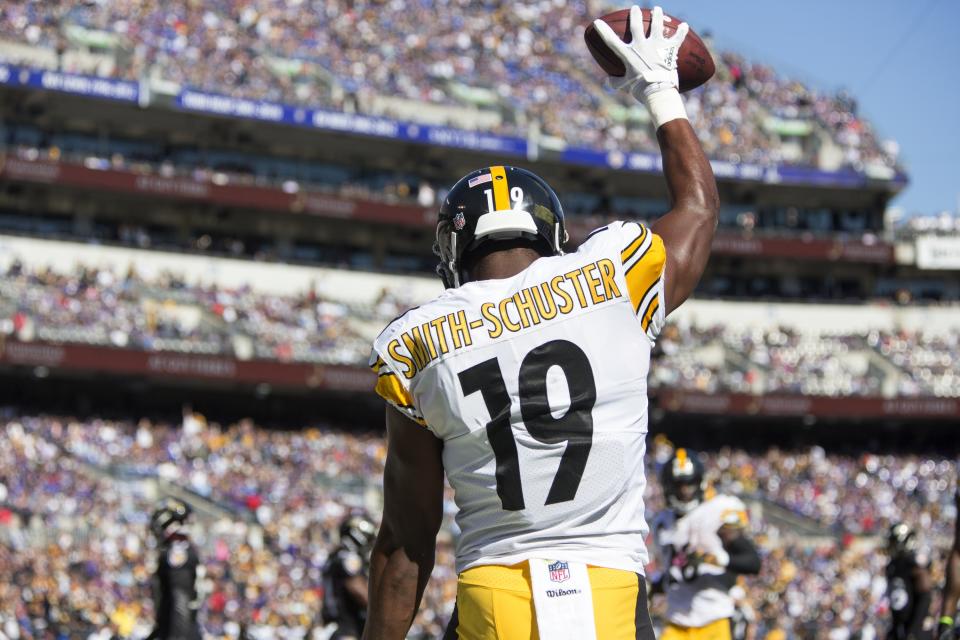Potential Fantasy Breakout WR2s: Who will steal the show this season?

By Matt Kelley, Player Profiler
Special to Yahoo Sports
The year was 2014, and wide receiver was king.
While Jeremy Hill, Justin Forsett, Eddie Lacy, C.J. Anderson, and Joique Bell somehow carved out meager existences at the top of the running back food chain, Antonio Brown, Julio Jones, Odell Beckham, Demaryius Thomas, and Jordy Nelson ruled fantasy football like the Tyrannosaurus Rex roaming the Jurassic period. It may seem like multiple millenia ago, but less than five years ago, wide receivers dominated the fantasy league leaderboards, and Zero RB drafters won all the championships.
[Make sports predictions to win cash prizes with Yahoo Fantasy Slate. Play for free]
Looking beyond the sexiest names at the top of the 2014 fantasy points archives, a curious fact emerges in the fossil records. No. 2 WRs from Emmanuel Sanders to Alshon Jeffery to Randall Cobb to Golden Tate to Roddy White to Eric Decker supercharged the fantasy WR1 and WR2 tiers. During that magical season for fantasy wide receivers, Brandon LaFell actually scored more PPR fantasy points per game than LeSean McCoy. Hold on to your butts.
The Return of the Wide Receiver
After a five-year extinction, No. 2 wide receivers have roared back to fantasy relevance in 2018. Most astounding, JuJu Smith-Schuster’s 22.9 PPR fantasy points per game ranks fourth among NFL wide receivers and slots in 3.9 point per game ahead of the Steelers’ No. 1 WR, Antonio Brown. Beyond the JuJu revelation, Emmanuel Sanders, DeSean Jackson, Stefon Diggs, and Brandin Cooks are positioned well inside the top-20 fantasy wide receivers all while not leading their respective teams in Target Share.

Beyond established veterans, the second-year leap is real. Through three weeks, “complimentary receivers” Kenny Golladay, Chris Godwin, and Mike Williams joined Smith-Schuster among the top-30 fantasy WRs — stunning, yet not stunning at all. Looking back through the fantasy football annuls, sophomore wide receivers offer the most asymmetrical upside in fantasy drafts, exemplified best by Stefon Diggs in 2016, Tyreek Hill in 2017, and Smith-Schuster in 2018.
The Skeleton Keys
As the enthusiasm around Calvin Ridley’s Week 3 splashes down and reaches a rookie fever crescendo, No. 2 options Will Fuller and Tyler Boyd are quietly cracking the top-20 fantasy wide receivers in their third year in the league. Fuller and Boyd are more interesting breakout case studies than Ridley. PlayerProfiler’s lifetime value projection model, which powers the Dynasty Rankings, identified Boyd and Fuller as strong fantasy values despite No. 2 wide receiver target shares.
Two metrics illuminated Fuller and Boyd’s upside. Age-adjusted college dominance and size-adjusted athleticism are the two keys to identifying breakout wide receivers. Featuring a 46.7% College Dominator Rating and 105.3 (83rd percentile) Speed Score, Fuller’s advanced prospect profile flashed green lights coming out of Notre Dame. Boyd’s 42.7% (86th percentile) College Dominator and 18.8 (92nd percentile) Breakout Age suggested he was one of the most precocious wide receivers to enter the NFL since 2014.
Christian Kirk
Taking the power of age-adjusted college dominance and size-adjusted athleticism into account, who are the next Fuller and Boyd? While Ridley has the Alabama pedigree, the draft capital, and the three-touchdown performance on this professional résumé, Christian Kirk best fits the profile of a breakout rookie No. 2 WR. As a true freshman at Texas A&M, Kirk posted 80 receptions for 1009 yards and 7 touchdowns. Like Tyreek Hill, Tyler Lockett (technically a No. 1 WR with Doug Baldwin sidelined), and Tyler Boyd, Kirk demonstrated excellent special awareness by excelling in special teams. He scored a mind-bending six punt return touchdowns before entering the NFL Draft at 21-years old.

Kirk is best comparable to Stefon Diggs on PlayerProfiler.com, and fellow rookie Josh Rosen took notice. Showing off their training camp rapport, Rosen targeted Kirk eight times in week 3, more than Larry Fitzgerald and David Johnson combined. Like Diggs before him, Kirk seized the No. 2 WR role early in his rookie year and is perfectly positioned to capitalized on Arizona’s long-awaited QB upgrade.
Antonio Callaway
After D.J. Moore, the most dynamic wide receiver in the NFL Draft was not a Day 1 or Day 2 selection. According to PlayerProfiler’s Data Analysis Tool, only Moore and James Washington sported an earlier Breakout Age than Antonio Callaway among 2018 NFL Draft prospects. Looking beyond age-adjusted production, like Fuller, Callaway’s 102.9 Speed Score crests the 75th percentile.
Who was the most heavily targeted rookie in week 3? Calvin Ridley? Wrong. Antonio Callaway’s 10 targets exceeded both Ridley and Kirk last week. Here Callaway’s weekly usage breakdown:
Week 1 (Josh Gordon played): 7 routes, 1 target
Week 2: 27 routes, 4 targets
Week 3: 36 routes, 10 targets
Like Kirk, Callaway is perfectly positioned to fill a talent void at No. 2 WR and capitalize on built-in rapport with a new, rising star quarterback.
Cameron Meredith
It may be a stretch for rookie quarterbacks to consistently sustain a fantasy relevant WR2. What about Drew Brees? Michael Thomas’ 38 receptions (most all-time through the first three weeks of the season) is unsustainable, but historically, Brees’ 40-plus pass attempts per game is sustainable. As Thomas is inevitably bracket-covered in the weeks ahead, Cameron Meredith should be a frequent target. As a converted college quarterback, Meredith does not offer the same college production metrics as Kirk and Callaway, but he offers something better: a full season of NFL efficiency, predominantly with Matt Barkley at quarterback.

After sitting out Weeks 1 and 2 to complete his double knee ligament tear rehabilitation, Meredith, and his 10.34 (95th percentile) Catch Radius, entered the Saints’ wide receiver rotation and ran an impressive 28 pass routes, 79.5% from the slot. His role will likely grow in the weeks ahead and provide Brees with a big slot option for the first time since Marques Colston roamed the bayou. Stash Meredith in fantasy football before he becomes the NFL’s next No. 2 WR breakout.
